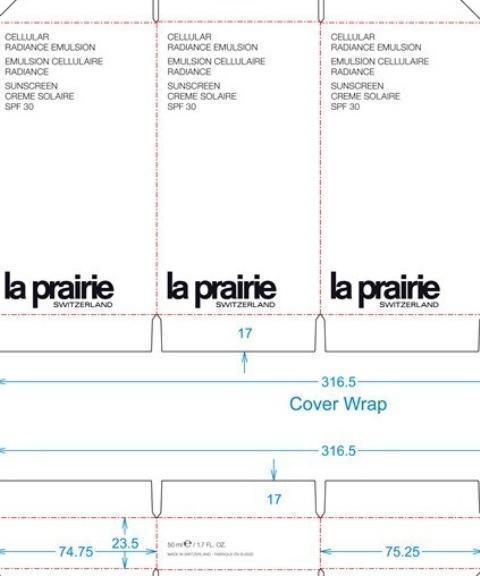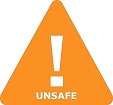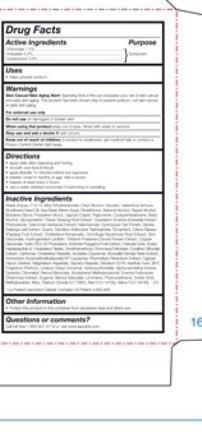Cellular Radiance Emulsion Spf 30 La Prairie | Avobenzone, Octinoxate, Octisalate Cream while Breastfeeding

What is Cellular Radiance Emulsion Spf 30 La Prairie | Avobenzone, Octinoxate, Octisalate Cream ?
Purpose: Uses helps prevent sunburn Keep out of reach of children. If swallowed, get medical help or contact a Poison Control Center right away. Stop use and ask a doctor if rash occurs Skin Cancer/Skin Aging Alert: Spending time in the sun increases your risk of skin cancer and early skin aging. This product has been shown only to prevent sunburn, not skin cancer or early skin aging. For external use only Do not use on damaged or broken skin When using this product keep out of eyes. Rinse with water to remove. Directions apply daily after cleansing and toning smooth over face and throat apply liberally 15 minutes before sun exposure children under 6 months of age: Ask a doctor reapply at least every 2 hours use a water resistant sunscreen if swimming or sweating Inactive Ingredients: Water (Aqua), C12-15 Alkyl Ethylhexanoate, Cetyl Alcohol, Glycerin, Helianthus Annuus (Sunflower) Seed Oil, Sea Water (Maris Aqua), Dimethicone, Behenyl Alcohol, Stearyl Alcohol, Butylene Glycol, Propylene Glycol, Caprylic/Capric Triglyceride, Cyclopentasiloxane, Batyl Alcohol, Glycoproteins, Panax Ginseng Root Extract, Equisetum Arvense (Horsetail) Extract, Phytosterols, Salicornia Herbacea Extract, Niacinamide, Hydrolyzed Oat Protein, Alpinia Galanga Leaf Extract, Quartz, Disodium Adenosine Triphosphate,Tocopherol, Carica Papaya (Papaya) Fruit Extract, Cholesteryl Nonanoate, Cimicifuga Racemosa Root Extract, Zinc Gluconate, Hydrogenated Lecithin, Trifolium Pratense (Clover) Flower Extract, Copper Gluconate, Gold, PEG-20 Phytosterol, Actinidia Polygama Fruit Extract, Acetyl Heptapeptide, Colloidal Gold, Cholesteryl Oleate, Dimethylmethoxy Chromanyl Palmitate, Corallina Officinalis Extract, Carbomer, Cholsteryl Stearate, Acrylates Copolymer, Boswellia Serrata Resin Extract, Ammonium Acryloyldimethltaurate/VP Copolymer, Phormidium Persicinum Extract, Caprylyl Glycol, Dextran, Magnesium Asparate, Glyceryl Stearate, Disodium EDTA, Xanthan Gum, BHT, Fragrance (Parfum), Linalool, Hexyl Cinnamal, Hydroxycitronellal, Alpha-Isomethyl Ionone, Geraniol, Citronellol, Benzyl Benzoate, Butylphenyl Methylpropional, Evernia Furfuracea (Treemoss) Extract, Eugenol, Benzyl Salicylate, Limonene, Phenoxyethanol, Sorbic Acid, Methylparaben, Mica, Titanium Dioxide (CI 77891), Red (CI 14700), Yellow 5 (CI 19140)
Can I use Cellular Radiance Emulsion Spf 30 La Prairie | Avobenzone, Octinoxate, Octisalate Cream while breastfeeding?

Avobenzone and Breastfeeding
SafeNot much study has been done on effects of topical usage of Avobenzone during breast feeding however it is known to penetrate the skin in very limited quantity. Its not very likely to have adverse effects in breastfed infants.
Note: Study and data for tropical use only, Breakdown product causes relatively high rates of skin allergy hence stabilization is required.Warning: Tropical usage in breast area shall be avoided to prevent the Avobenzone passing orally in Infants.
Octinoxate and Breastfeeding
Unsafe
Octinoxate (Octylmethoxycinnamate) has been detected in human urine, blood and breast milk and is known for moderate risk of skin allergy. Some studies suggest that Octinoxate has estrogen like effects however less than 1% skin penetration has been found in human laboratory studies. As not much study has been done on effects of Octinoxate during breast feeding its recommended to use safe alternatives.
Octyl Methoxycinnamate (OMC) is a frequently used UV-filter in sunscreens and other cosmetics. Octinoxate can be systemically absorbed after skin application, being found in the deeper layers of the stratum corneum as well as urine, plasma, and breast milk. The mean maximum plasma concentration detected after application of 2mg/cm2 sunscreen was 7ng/mL in women and 16ng/mL in men. FDA study found blood levels 13 times above cutoff for systemic exposure.
Several studies indicated that OMC acts as an endocrine disruptor due to the ability to interfere with endocrine system at different levels. In humans OMC exposure has minor, but statistically significant effects on the levels of testosterone and estradiol. Moreover, some studies suggested that OMC can interact with the hypothalamo-pituitary-thyroid (HPT) axis.
Moreover, a study of offspring of dams treated with OMC (500�1000 mg/kg/day) showed sex-dependent behavioral changes, namely decreased motor activity in females, but not in males, and improved spatial learning in males, suggesting that OMC can affect neuronal development, however the doses used in these experiments were extremely high, not relevant to possible human exposure.
Note: Study and data for tropical use onlyWarning: High dosage shall be avoided as reproductive system, thyroid and behavioral alterations in animal studies has been found, Tropical usage in breast area shall be avoided to prevent the OCTINOXATE passing orally in Infants.
Octisalate and Breastfeeding
Low RiskOctyl salicylate is an oil soluble chemical sunscreen agent that absorbs UVB radiation. It does not protect against UVA. Octyl salicylate is used to augment the UVB protection in a sunscreen. Salicylates are weak UVB absorbers and they are generally used in combination with other UV filters
Octisalate rarely causes allergies in tropical usage. Not much study has been done on effects of topical usage of Octisalate during breast feeding however it is known to penetrate the skin hence it�s better to use other alternatives.
FDA study found blood levels 10 times above cutoff for systemic exposure, skin penetration in lab studies has been observed
Note: Study and data for tropical use onlyWarning: Tropical usage in breast area shall be avoided to prevent the Octisalate passing orally in Infants.
What should I do if I am breastfeeding mother and I am already exposed to Cellular Radiance Emulsion Spf 30 La Prairie | Avobenzone, Octinoxate, Octisalate Cream?
We have already established that Cellular Radiance Emulsion Spf 30 La Prairie | Avobenzone, Octinoxate, Octisalate Cream is unsafe in breastfeeding and breastfeeding while using Cellular Radiance Emulsion Spf 30 La Prairie | Avobenzone, Octinoxate, Octisalate Cream is not a good idea however if have already used
My doctor has prescribed me Cellular Radiance Emulsion Spf 30 La Prairie | Avobenzone, Octinoxate, Octisalate Cream, what should I do?
If your doctor knows that you are breastfeeding mother and still prescribes Cellular Radiance Emulsion Spf 30 La Prairie | Avobenzone, Octinoxate, Octisalate Cream then there must be good reason for that as Cellular Radiance Emulsion Spf 30 La Prairie | Avobenzone, Octinoxate, Octisalate Cream is considered unsafe, It usually happens when doctor finds that overall advantage of taking
If I am using Cellular Radiance Emulsion Spf 30 La Prairie | Avobenzone, Octinoxate, Octisalate Cream, will my baby need extra monitoring?
Yes, Extra monitoring is required if mother is using Cellular Radiance Emulsion Spf 30 La Prairie | Avobenzone, Octinoxate, Octisalate Cream and breastfeeding as it is considered unsafe for baby.
Who can I talk to if I have questions about usage of Cellular Radiance Emulsion Spf 30 La Prairie | Avobenzone, Octinoxate, Octisalate Cream in breastfeeding?
US
National Womens Health and Breastfeeding Helpline: 800-994-9662 (TDD 888-220-5446) 9 a.m. and 6 p.m. ET, Monday through Friday
UK
National Breastfeeding Helpline: 0300-100-0212 9.30am to 9.30pm, daily
Association of Breastfeeding Mothers: 0300-330-5453
La Leche League: 0345-120-2918
The Breastfeeding Network supporter line in Bengali and Sylheti: 0300-456-2421
National Childbirth Trust (NCT): 0300-330-0700
Australia
National Breastfeeding Helpline: 1800-686-268 24 hours a day, 7 days a week
Canada
Telehealth Ontario for breastfeeding: 1-866-797-0000 24 hours a day, 7 days a week
